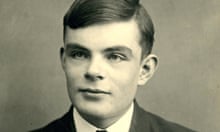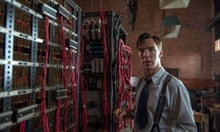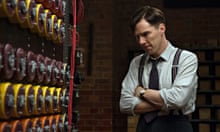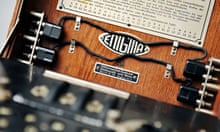On 12 November 1942, the mathematician Alan Turing arrived in New York, bound for Washington DC and the headquarters of the US Secret Service, an organisation now known as the CIA. More than 500 American ships had been sunk by German U-boats since the US began sending supplies across the Atlantic to Europe in 1941 and naval authorities were growing impatient with Britain’s reluctance to share more than cursory details of progress at decrypting messages sent by the German high command and encoded by the Enigma machine.
Officially, Turing was meant to disclose everything he and his team at Bletchley Park knew about the workings of Enigma. In reality, he was under strict instructions from MI6 to act as its official liar and keep the Americans in the dark as much as possible. It was a strange role for a Cambridge mathematician with a fondness for crossword puzzles, but Turing’s wartime work had landed him in the midst of a game of high-stakes diplomacy.
Unknown to the Americans, Britain had been deciphering messages to and from the German U-boat fleet since the summer of 1940. Within weeks of arriving at Bletchley Park, Turing had invented an electromechanical machine called the Bombe that could break any Enigma-coded message. The machine required two things – knowledge of the Enigma hardware and a plain-text “crib” of around 20 characters likely to be in the message, inferred using facts such as the weather and key dates such as Hitler’s birthday.
Few were allowed to know. Most government officials and British naval officers believed the vital information was coming from an MI6 master spy codenamed “Boniface” who reportedly controlled a network of agents throughout Germany. Boniface and his team of spies were entirely fictional.
One of those who knew the truth was the future author of the James Bond novels, Ian Fleming, who was then working as a lieutenant commander in Britain’s naval intelligence division. Fleming was involved in devising operations based on intelligence received from Bletchley Park, but judging from his diary entries at the time, it is clear that he and Turing didn’t see eye to eye.
“One of the reasons how we know Turing was so heavily involved with MI6 during the war is due to Fleming’s diaries,” says Graham Moore, scriptwriter and producer of The Imitation Game, which is finally released in the US on Friday. “Most of the time he’s writing about how annoyed he is with Turing. Fleming was regularly proposing plans and Turing was apparently in a position to be able to reject them. Fleming makes it clear he doesn’t like the look of him. There’s a memorable extract where he writes ‘Turing came in like an undertaker’ and shot down whatever he was saying. One imagines they were two very different sorts of British gentlemen.”
MI6 was especially wary of letting its American allies into the loop, fearing not only that the information would leak but that Britain would receive little of value in return. With the US Navy and US Army operating almost entirely independently, often plotting against each other, British intelligence was convinced the information would be used unwisely.
Turing’s role in Washington was to liaise with the leading American cryptanalysts and convince them that Britain was struggling to match their expertise while taking note of the machines they were developing, in particular a speech encryption system being developed for private conversations between Winston Churchill and Franklin Roosevelt. Judging by the minutes of the meetings, it’s a role he played perfectly, in a stark contrast to his common portrayal on screen as someone incapable of judging the nuances of social situations.
“He absolutely hated it because he had to play dumb while being grilled by these mathematicians,” Moore says. “He had to pretend to be wowed by the progress the Americans were making even though they were light years behind the British at that point. But he had them convinced.”
Turing’s own reports from Washington are filled with disdain for what he saw as America’s overreliance on technology rather than thought. “I am persuaded that one cannot very well trust these people where a matter of judgment in cryptography is concerned,” he wrote. “It astonished me to find that they make these elaborate calculations before they had really grasped the main principles. [But] I think we can make quite a lot of use of their machinery.”
American culture was alien to Turing, who was irritated by what he saw as their incessant need for irrelevant small talk. “In one of his letters home, he’s complaining about their speech and the fact they kept saying ‘ummm’, ‘errrr’, ‘but’ and all these little stutters which got on his nerves,” Moore says. “He writes ‘Just say the sentence and then stop!’”
Ironically, it was Turing’s trip to Washington that inspired some of the work in the post-war years he is best remembered for and in particular his 1950 paper on a machine that could think for itself. He met Claude Shannon, now known as “the father of information theory”, and had a lengthy conversation about the idea of building an electronic brain – a discussion that excited Turing so much he immediately bought himself a book on electronic components for the long journey back across the Atlantic.
Turing went on to be involved in some of the earliest experiments in artificial intelligence, designing computer programs to play draughts and even write love letters. But one Tuesday morning in June 1954, he was found dead by his housekeeper, a half-eaten apple by his bedside. A postmortem concluded that cyanide poisoning was the cause of death, though the apple was not tested.
Two years previously, Turing had been convicted of gross indecency and given the choice of prison or hormone treatment. He chose the latter, which rendered him impotent, and as a result of the conviction he lost his security clearance and role working for GCHQ, the government’s communication headquarters.
This appears to support the suicide hypothesis, but Turing’s level of access to sensitive information during the war has only added to the enduring mystery of how he died. Turing’s mother blamed her son’s careless attitude towards the storing of dangerous chemicals. He had set up an electrical lab in the spare room of his cramped lodgings in order to run experiments and it was suggested that the apple had become contaminated this way. However some feel this story is simply too convenient.
“There are a large number of people who think he was deliberately killed because the government were afraid he was going to talk,” Moore says. “The British had given Enigma to Israel, saying it was an unbreakable machine and they should use it for all their communication. They didn’t tell anyone they had actually broken it and were continuing to listen in. So there was a lot of bluff and counter bluff going on.”
However Mortem Tyldum, director of The Imitation Game, has a different theory. He believes the key to the mystery lies in Turing’s fascination with the Disney film Snow White.
“There’s a scene I desperately tried to get in where he was waiting in Bletchley village to be interviewed by Commander Dennison for a code-breaking position at the start of the war. He was early and at the village cinema they were showing Snow White. So he popped in, fell in love with the movie and almost became obsessed with it. I think this gave him the idea of a suicide apple, and perhaps led him to actually kill himself.”








Comments (…)
Sign in or create your Guardian account to join the discussion